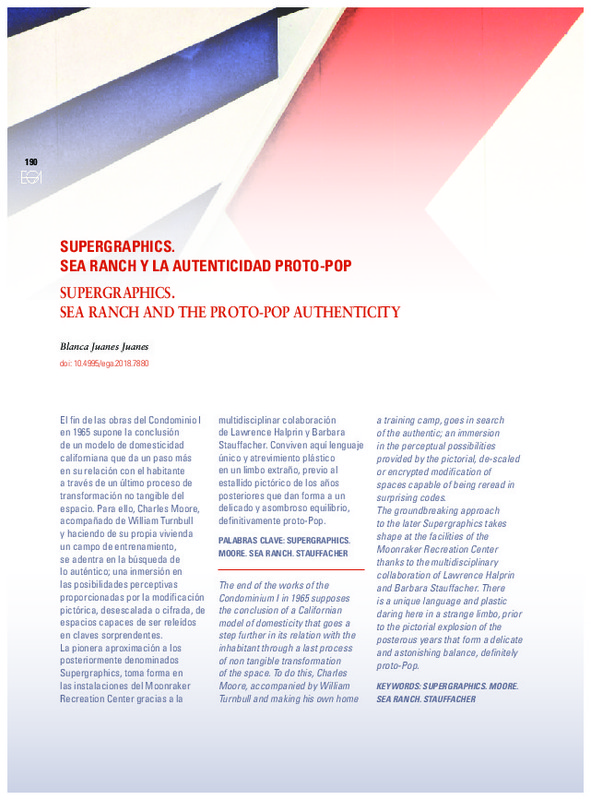JavaScript is disabled for your browser. Some features of this site may not work without it.
Buscar en RiuNet
Listar
Mi cuenta
Estadísticas
Ayuda RiuNet
Admin. UPV
Supergraphics. Sea Ranch y la autenticidad Proto-Pop
Mostrar el registro sencillo del ítem
Ficheros en el ítem
| dc.contributor.author | Juanes Juanes, Blanca
|
es_ES |
| dc.date.accessioned | 2018-11-29T09:09:04Z | |
| dc.date.available | 2018-11-29T09:09:04Z | |
| dc.date.issued | 2018-07-13 | |
| dc.identifier.issn | 1133-6137 | |
| dc.identifier.uri | http://hdl.handle.net/10251/113308 | |
| dc.description.abstract | [EN] The end of the works of the Condominium I in 1965 supposes the conclusion of a Californian model of domesticity that goes a step further in its relation with the inhabitant through a last process of non tangible transformation of the space. To do this, Charles Moore, accompanied by William Turnbull and making his own home a training camp, goes in search of the authentic; an immersion in the perceptual possibilities provided by the pictorial, de-scaled or encrypted modification of spaces capable of being reread in surprising codes. The groundbreaking approach to the later Supergraphics takes shape at the facilities of the Moonraker Recreation Center thanks to the multidisciplinary collaboration of Lawrence Halprin and Barbara Stauffacher. There is a unique language and plastic daring here in a strange limbo, prior to the pictorial explosion of the posterous years that form a delicate and astonishing balance, definitely proto-Pop. | es_ES |
| dc.description.abstract | [ES] El fin de las obras del Condominio I en 1965 supone la conclusión de un modelo de domesticidad californiana que da un paso más en su relación con el habitante a través de un último proceso de transformación no tangible del espacio. Para ello, Charles Moore, acompañado de William Turnbull y haciendo de su propia vivienda un campo de entrenamiento, se adentra en la búsqueda de lo auténtico; una inmersión en las posibilidades perceptivas proporcionadas por la modificación pictórica, desescalada o cifrada, de espacios capaces de ser releídos en claves sorprendentes.La pionera aproximación a los posteriormente denominados Supergraphics, toma forma en las instalaciones del Moonraker Recreation Center gracias a la multidisciplinar colaboración de Lawrence Halprin y Barbara Stauffacher. Conviven aquí lenguaje único y atrevimiento plástico en un limbo extraño, previo al estallido pictórico de los años posteriores que dan forma a un delicado y asombroso equilibrio, definitivamente proto-Pop. | es_ES |
| dc.language | Español | es_ES |
| dc.language | Inglés | es_ES |
| dc.publisher | Universitat Politècnica de València | |
| dc.relation.ispartof | EGA. Revista de Expresión Gráfica Arquitectónica | |
| dc.rights | Reserva de todos los derechos | es_ES |
| dc.subject | Supergraphics | es_ES |
| dc.subject | Moore | es_ES |
| dc.subject | Sea Ranch | es_ES |
| dc.subject | Stauffacher | es_ES |
| dc.title | Supergraphics. Sea Ranch y la autenticidad Proto-Pop | es_ES |
| dc.title.alternative | Supergraphics. Sea Ranch and the proto-Pop authenticity | es_ES |
| dc.type | Artículo | es_ES |
| dc.date.updated | 2018-11-28T13:27:14Z | |
| dc.identifier.doi | 10.4995/ega.2018.7880 | |
| dc.rights.accessRights | Abierto | es_ES |
| dc.description.bibliographicCitation | Juanes Juanes, B. (2018). Supergraphics. Sea Ranch y la autenticidad Proto-Pop. EGA. Revista de Expresión Gráfica Arquitectónica. 23(33):190-201. https://doi.org/10.4995/ega.2018.7880 | es_ES |
| dc.description.accrualMethod | SWORD | es_ES |
| dc.relation.publisherversion | https://doi.org/10.4995/ega.2018.7880 | es_ES |
| dc.description.upvformatpinicio | 190 | es_ES |
| dc.description.upvformatpfin | 201 | es_ES |
| dc.type.version | info:eu-repo/semantics/publishedVersion | es_ES |
| dc.description.volume | 23 | |
| dc.description.issue | 33 | |
| dc.identifier.eissn | 2254-6103 | |
| dc.description.references | JENCKS, Charles. The Language of Post-modern Architecture. New York: Rizzoli, 1977. | es_ES |
| dc.description.references | BACHELARD, Gastón. La poética del espacio. México D.F.: Fondo de Cultura Económica, 1965. | es_ES |
| dc.description.references | DIAMONSTEIN-SPIELVOGEL, Barbaralee, and I. M PEI. American Architecture Now. New York: Rizzoli, 1980. | es_ES |
| dc.description.references | LITTLEJOHN, David. Architect: the Life and Work of Charles W. Moore. New York: Holt, Rinehart and Winston, 1984. | es_ES |
| dc.description.references | MCMORROUGH, John. "Blowing the lid off paint", en Hunch 11: Rethinkinh Representation, ed. Penelope Dean, | es_ES |
| dc.description.references | MOORE, Charles Willard y otros. The Sea Ranch, California, 1966. Tokyo: A.D.A. Edita, 1971. | es_ES |
| dc.description.references | MOORE, Charles Willard y otros. The Sea Ranch Condominium and Athletic Club 1 & 2, Sea Ranch, California, 1963-69. Tokyo: A.D.A. Edita, 1976. | es_ES |
| dc.description.references | MOORE, Charles Willard, and Kevin P KEIM. You Have to Pay for the Public Life : Selected Essays of Charles W. Moore. Cambridge, Mass.: MIT Press, 2001. | es_ES |
| dc.description.references | OTERO-PAILOS, Jorge. Architecture's Historical Turn : Phenomenology and the Rise of the Postmodern. Minneapolis: University of Minnesota Press, 2010. https://doi.org/10.5749/minnesota/9780816666034.001.0001 | es_ES |
| dc.description.references | McMorrough, John. "Blowing the lid off paint," en Hunch 11: Rethinking Representationn, ed. PenelopeDean, 64-75. Rotterdam: Episode Publisers, 2007 | es_ES |
| dc.description.references | RaySmith, Charles. "Bathhouse Graphics", Progressive Architecture, Marzo, 1967, 156-161. | es_ES |
| dc.description.references | RaySmith, Charles. "The Freeway comes Indoors", Progressive Architecture, Octubre, 1967, 164-168. | es_ES |
| dc.description.references | RaySmith, Charles. "The Permissiveness of Supermannerism", Progressive Architecture, Octubre, 1967, 169-173. | es_ES |
| dc.description.references | RaySmith, Charles. "Supergraphichs", Progressive Architecture, Noviembre, 1967, 132-137. | es_ES |








